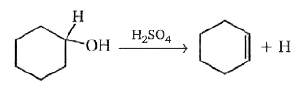Which of the following is a β-elimination reaction ?

(2) CHCl3+KOHΔ−−→CCl3


The correct Answer is:D
To determine which of the given reactions is a beta-elimination reaction, we need to understand the definition of a beta-elimination reaction. A beta-elimination reaction involves the removal of two atoms or groups from adjacent carbon atoms in a substrate molecule.
1. Understanding Beta-Elimination:
- In a beta-elimination reaction, two atoms or groups are removed from adjacent carbon atoms (C1 and C2). This process typically leads to the formation of a double bond between these two carbon atoms.
2. Analyzing the First Reaction:
- In the first reaction, we have a substrate that reacts with sodium hydroxide to form a three-membered ring.
- The atoms eliminated are bromine (Br) from carbon 1 and a hydrogen atom from an oxygen (not from carbon 2).
- Since the hydrogen is not from the adjacent carbon (C2), this reaction does not qualify as a beta-elimination reaction.
3. Analyzing the Second Reaction:
- The second reaction involves CHCl3 reacting with a base, resulting in the formation of CCl3.
- Here, only hydrogen is eliminated, and there is no elimination from adjacent carbon atoms. Thus, this is also not a beta-elimination reaction.
4. Analyzing the Third Reaction:
- In the third reaction, a substrate reacts with a hydroxyl radical to form a cyclic compound.
- In this case, bromine is eliminated from one carbon and hydrogen from another carbon, but they are not adjacent (1,3 elimination). Therefore, this is not a beta-elimination reaction.
5. Analyzing the Fourth Reaction:
- In the fourth reaction, chlorine (Cl) is eliminated from carbon 1 and hydrogen from carbon 2.
- Here, we see that both atoms are eliminated from adjacent carbon atoms (C1 and C2), which fits the definition of a beta-elimination reaction.
6. Conclusion:
- Based on the analysis, the fourth reaction is the only one that qualifies as a beta-elimination reaction.
Final Answer:
The fourth reaction is a beta-elimination reaction.
---
- In a beta-elimination reaction, two atoms or groups are removed from adjacent carbon atoms (C1 and C2). This process typically leads to the formation of a double bond between these two carbon atoms.
- In the first reaction, we have a substrate that reacts with sodium hydroxide to form a three-membered ring.
- The atoms eliminated are bromine (Br) from carbon 1 and a hydrogen atom from an oxygen (not from carbon 2).
- Since the hydrogen is not from the adjacent carbon (C2), this reaction does not qualify as a beta-elimination reaction.
- The second reaction involves CHCl3 reacting with a base, resulting in the formation of CCl3.
- Here, only hydrogen is eliminated, and there is no elimination from adjacent carbon atoms. Thus, this is also not a beta-elimination reaction.
- In the third reaction, a substrate reacts with a hydroxyl radical to form a cyclic compound.
- In this case, bromine is eliminated from one carbon and hydrogen from another carbon, but they are not adjacent (1,3 elimination). Therefore, this is not a beta-elimination reaction.
- In the fourth reaction, chlorine (Cl) is eliminated from carbon 1 and hydrogen from carbon 2.
- Here, we see that both atoms are eliminated from adjacent carbon atoms (C1 and C2), which fits the definition of a beta-elimination reaction.
- Based on the analysis, the fourth reaction is the only one that qualifies as a beta-elimination reaction.
The fourth reaction is a beta-elimination reaction.
Topper's Solved these Questions
- ORGANIC REACTION MECHANISMS-IVBOOK - RESONANCE ENGLISHCHAPTER - ORGANIC REACTION MECHANISMS-IVEXERCISE - APSP PART-2
17 Videos
- ORGANIC REACTION MECHANISMS-IVBOOK - RESONANCE ENGLISHCHAPTER - ORGANIC REACTION MECHANISMS-IVEXERCISE - APSP PART-3
22 Videos
- ORGANIC REACTION MECHANISMS-IVBOOK - RESONANCE ENGLISHCHAPTER - ORGANIC REACTION MECHANISMS-IVEXERCISE - Exercise-3 Part-2 JEE (MAIN ) ONLINE PROBLEMS
10 Videos
- ORGANIC REACTION MECHANISMS - IIBOOK - RESONANCE ENGLISHCHAPTER - ORGANIC REACTION MECHANISMS - IIEXERCISE - APSP Part - 3
22 Videos
- PERIODIC TABLE & PERIODICITYBOOK - RESONANCE ENGLISHCHAPTER - PERIODIC TABLE & PERIODICITYEXERCISE - ORGANIC CHEMISTRY(BASIC CONCEPTS)
27 Videos
Similar Questions
Knowledge Check
Which of the following is B-elimination reaction?
A BCHBr3+Me3CΘOK⊕→:CBr2C
BCHBr3+Me3CΘOK⊕→:CBr2C D
D
Which of the following reaction is an elimination reaction ?
A B
B C
C Dboth (a) and (b)
Dboth (a) and (b)
Hofmann elimination reaction.
View SolutionHofmann elimination reaction.
View SolutionHofmann elimination reaction.
View SolutionDefine elimination reactions.
View Solution
Identify the product of the following elimination reaction X and Y respectively with stereochemistry :
View SolutionIn which of the following Hoffmann elimination product is more ?
View Solution
 .
.